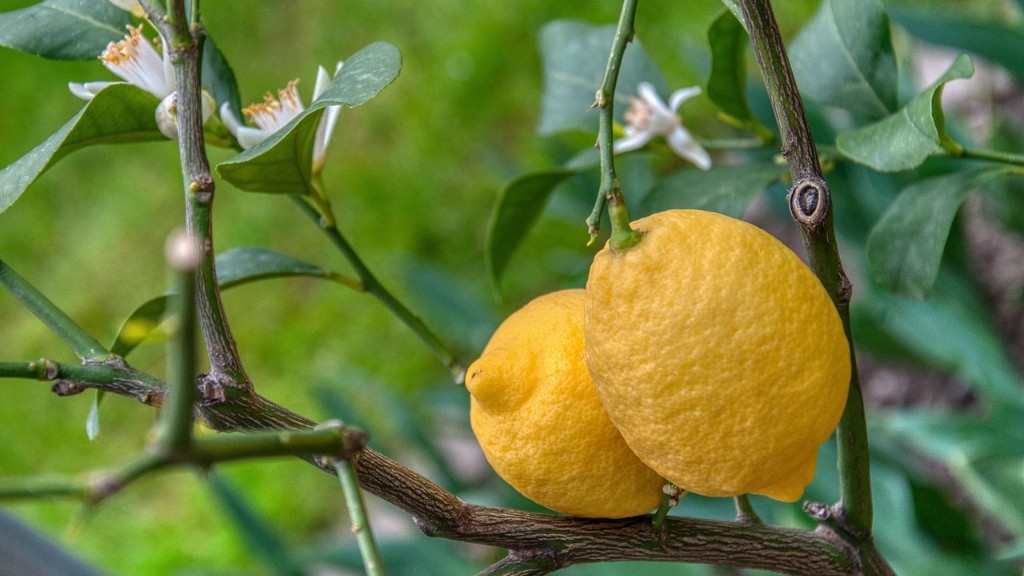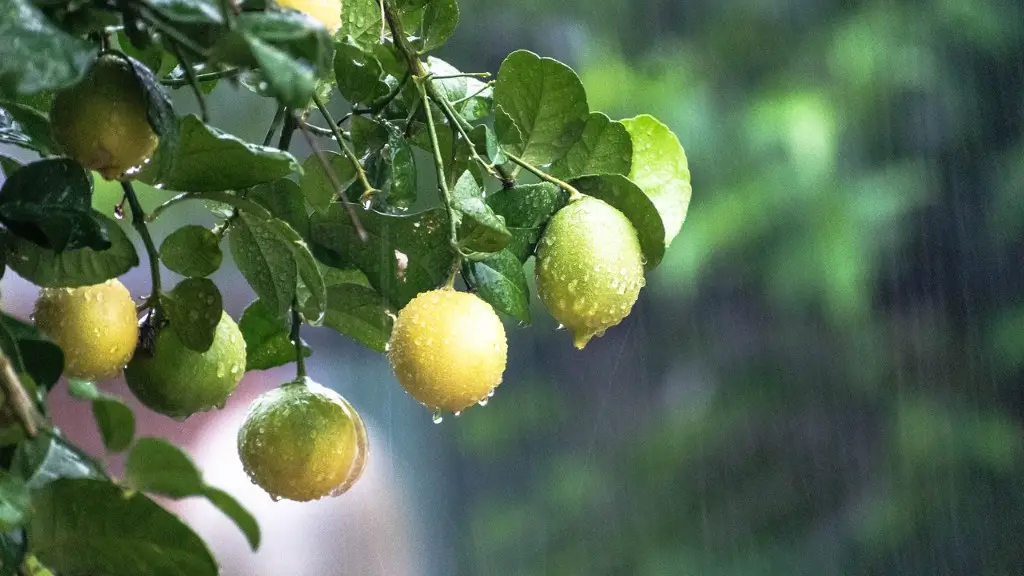Potted lemon trees are common outdoor plants that can easily be brought inside with the correct knowledge. With careful consideration and proactive actions, a lemon tree can thrive both in and outside of the house. It is crucial that a few factors are taken into account when deciding when to bring the plant inside.
Temperature is the most significant variable that must be known beforehand. The ideal temperature for a lemon tree is 55-85° F; temperatures lower than this can lead to a lack of photosynthesis and diminished plant growth. Additionally, if temperatures drop below 32°F, the tree may die completely. Distinguishing between a day’s temperature and the night temperature is necessary as well, as plants may need protection during the colder nights.
Light is another key factor when positioning a potted lemon tree inside. Lemon trees require strong, direct sunlight for several hours a day, otherwise they may not survive. If the indoors area is too dark, the tree will become stressed and might not be able to produce any lemons.
Insects are another issue – indoor plants may not be as exposed to outside bugs and diseases, however, it doesn’t necessarily mean they are immune. Checking for pesky bugs and diseases on the leaves and stems should be a daily or weekly task as soon as the tree is purchased.
Finally, before transitioning the potted lemon tree inside, ventilation should be considered. Keeping the plant in a room that has excellent air flow and ventilation ensures the healthy development of the tree, as the humidity content will be minimized.
The Impact of Space
Space is an essential factor to consider when bringing a potted lemon tree inside. Lemon trees can grow to be five to ten feet tall, meaning they need room to grow. Placing a tree too close to other plants and furniture can limit the resources the lemon tree has access to and stunt its growth. Having enough space is essential so that it can spread its roots, have room to breathe and flower indoors.
Light exposure is also impacted by the surrounding space. Too much shade may affect the tree’s ability to photosynthesize and thus grow. Similarly, if the lemon tree is placed in close proximity to windows and glass doors, refracted sunlight can reach it; while certain types of plants like more filtered sunlight, the lemon tree requires direct exposure.
Location should also be taken into account when determining how much space the potted lemon tree will require. Depending on the tree’s size, positionind the pot in front of a window may not be a practical decision – either due to size or the tree’s sunlight needs.
The inside environment is also of concern. Placing the tree in an area that’s prone to high amounts of traffic may damage the tree’s roots as a result of constant movement and displacement. Lemon trees are known for their extended root systems, and need a stable space that’s safe from any type of movement.
Signs To Bring The Tree Inside
When temperatures start to reach below 50°F or show signs of freezing, the potted lemon tree should be brought inside. This should be done as soon as possible, and the tree must be inspected carefully for any type of insects and diseases.
Apart from temperature, other cues include leaves changing color, drooping and wilting. Furthermore, if a cool, dry wind is passing through, this could affect the tree’s hydration. Should the soil become too dry, the tree needs to be placed indoors where the humidity will be able to keep the soil moist.
The true telltale sign of when to bring the lemon tree inside is the presence of lemons. As the outdoor temperature continues to plummet, the flowers and small lemon buds may start to droop, indicating a need to be moved.
If the tree has already produced lemons, bringing it inside is necessary. Apart from the obvious fruit drooping, small lumps or patches may be visible on the lemons, this could be a sign of rot due to the cold temperatures.
How To Transition The Plant Inside
The first step to transitioning a potted lemon tree indoors is to inspect the tree for signs of pests and diseases. If there any present, it is sensible to prune them away so that they do not spread to other plants or to the foliage or fruits of the lemon tree.
The tree must then be moved inside and placed in a sunny, warm location in the house. Make sure the newly found spot is open and away from busy areas where the tree may be bumped or disturbed.
It is key to water the lemon tree regularly, but be careful not to overdo it; a proper hydration routine should be established. If the soil feels dry and the tree is wilting, that’s a sign it needs to be watered; however, if the soil feels too moist that’s a sign you may be over-watering.
Good Sunlit Locations
South-facing windows are the best spot for a potted lemon tree, as they are exposed to the most sunlight. This direct exposure helps to promote photosynthesis and consequently, tree growth.
East-facing windows give way to indirect morning sunlight, enough to satiate their needs but not to the extent of a south-facing window.
West-facing windows give way to direct afternoon sunlight that helps the tree to grow; however, direct exposure to the hottest part of the day might be damaging in certain cases.
Finally, north-facing windows don’t provide much sunlight, if any. Therefore, although it’s an option for a temporary spot for the tree, it is not ideal for durations lasting more than a couple of days.
Nutrition and Fertilizers
Most regions have specific fertilizer recommendations, dependent on the soil, climate, tree type and location. Consulting with local garden shops or agricultural services is useful in this regard – they will be able to provide you with the necessary information concerning the type of fertilizer that the tree needs.
Nutrition requirements vary greatly in potted lemon trees, as they depend on the amount of soil; in certain cases, root-bound trees require more frequent nutrition applications, whereas trees with ample soil may only require occasional nutrition boosting.
Organic fertilizer is the best option for lemon trees, as it offers important elements for soil nourishment, including phosphorus and nitrogen. Organic fertilizers come in the form of manure or can be bought in powder form at garden centres.
Pruning Care
Pruning care is important for the health of a potted lemon tree, especially when bringing it indoors. Pruning helps to promote a balanced, compact growth; in order to achieve this, all shoots that grow out perpendicularly should be pruned away when they reach two inches in length.
Furthermore, if weak, old or dead branches are present, they must be snipped off as soon as possible so as to allow for better circulation of light and space for other branches. It is important to prune away any cankered, diseased or inactive branches.
Pruning also benefits the tree aesthetically; when bringing a tree indoors, it is important to prune away any damaged leaves or branches in order to make it look the best it can.
Watering Routine
The key to proper inside watering for potted lemon trees is moderation. Too much water can result in root rot, whereas too little water can induce wilting.
When soil is dry, water is needed. If the plant feels too wet, it needs to be left alone. Establishing a consistent and moderate watering schedule is necessary so that it places the tree in neither situation.
For lemon trees, allowing the soil to completely dry a couple of days after each watering is essential, as this prevents waterlogging. Ensuring that the plant is not waterlogged is particularly important when bringing the tree indoors, as their natural support systems may not be present.
Benefits Of Indoor Placement
Indoor trees typically require less maintenance and nourishment than outdoor plants, as indoor environments are less vulnerable to diseases and weather. Indoor areas are less exposed to pests, therefore less insecticides are necessary for controlling them.
Indoor lemon trees are easier to observe, making it much easier to note any signs of wilt or insect infestation. As indoor areas are much safer for plants, the most vulnerable parts of the tree, such as the roots and the first few inches of the stems, are protected from harm.
Indoors, plants are not exposed to wind, rain or snow. This eliminates the possibility of them becoming waterlogged or beaten down, a common problem for outdoor trees.
Finally, indoors plants are in a controlled, consistent environment that they can thrive in, as long as it is properly managed and categorized as to temperature, spacing and light needs, as these are the three most important fundamentals all plants require.


